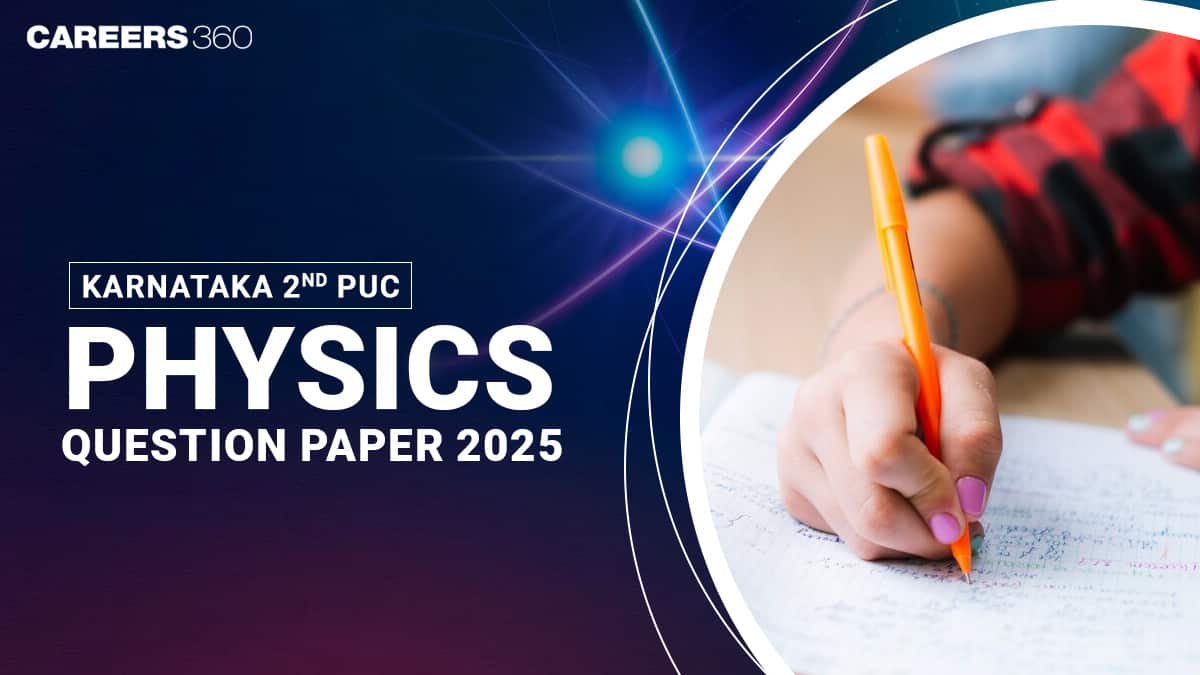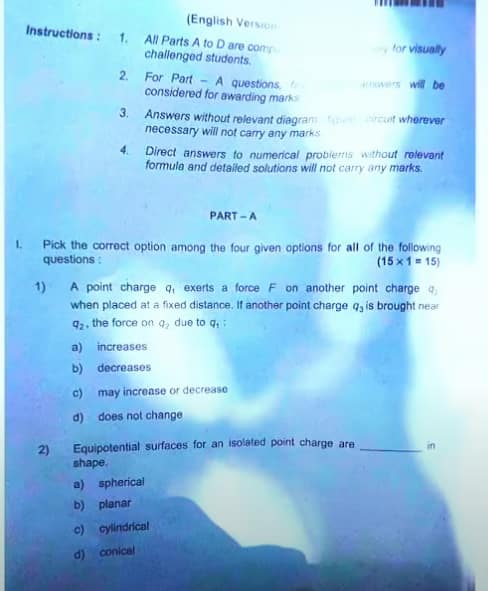Karnataka 2nd PUC Physics Question Paper 2025 (7th March), Download Solutions PDF
Karnataka PUC Board Exam Date:28 Feb' 26 - 28 Feb' 26
The Karnataka School Examination Board and Assessment (KSEAB) is conducting the 2nd PUC examination from March 1st 2025. As per Karnataka 2nd PUC timetable, the Physics subject exam was scheduled for 7th March 2025, from 10 am to 1 pm. Students can download the Karnataka 2nd PUC Physics question paper 2025 PDF along with the solution and answer key 2025 from this page.
This Story also Contains
- Karnataka 2nd PUC Physics Question Paper 2025: Highlights
- 2nd PUC Physics Question Paper 2025 PDF
- Karnataka 2nd PUC Physics Answer Key and Solution
- Karnataka II PUC Physics Board Exam Expected Questions

Karnataka PUC physics question paper 2025 had a moderate level of difficulty, as expecte,d with the same level of difficulty as last year.
Karnataka 2nd PUC Physics Question Paper 2025: Highlights
Important highlights of Karnataka 2nd PUC physics exam are given below:
| Particulars | Details |
|---|---|
Exam Name | Karnataka 2nd PUC Physics Exam 2025 |
Conducting Body | Karnataka Secondary Education Examination Board (KSEEB) |
Exam Date | March 07, 2025 |
Exam Time | 10:00 AM to 1:00 PM |
Mode of Exam | Offline (Pen and Paper) |
Total Marks | 70 (Theory) |
Total Questions | 45 (Only 35 need to be answered) |
Question Paper Availability | After the Exam |
Answer Key Release Date | March 7, 2025 (Unofficial), Official Key to be Released Later |
Exam Pattern | Objective and Descriptive Questions |
Marking Scheme | - Very Short Answer (VSA): 1 Mark - Short Answer (SA): 2 Marks - Long Answer (LA): 3-5 Marks - Numerical/Derivations: 4-5 Marks |
How to Calculate Scores? | Match answers with the key, follow the marking scheme, add marks for correct responses |
2nd PUC Physics Question Paper 2025 PDF
Students can download the Karnataka PUC physics question paper PDF and practice from it for the next exam. Students who are going to appear next year must go through the previous year's question paper PDF.
| Question Paper | Download PDF |
|---|---|
Karnataka 2nd PUC Physics Question Paper 2025 | Click Here |

1) A point charge q1 exerts a force F on another point charge ql when placed at a fixed distance. If another point charge q3 is brought near q2, the force on q2 due to q1 :
a) increases
b) decreases
c) may increase or decrease
d) does not change
2) Equipotential surfaces for an isolated point charge are in shape.
a) spherical
b) planar
c) cylindrical
d) conical
3) The final image of a real object formed by .a. microscope is
with respect to the object.
a) real, inverted and magnified
b) virtual, erect and magnified
c) virtual, erect and diminished
virtual, inverted and magnified
4) Which one of the following statements is WRONG about intertmoneco of light? ◻ Light waves of same wavelength coming from two independent sources can be coherent and can produce interference
b) When the path difference between two interfering waves in ald bright fringe is produced (Here n=0,1,2,… and λ is the wavelength of light)
c) When the phase difference between two interfering waves is (2n+1)π, dark fringe is produced (Here n=0,1,2,…)
d) In Young's double-slit experiment, dark and bright fringes are equally spaced
5) A ball is dropped from a certain height and it falls freely under gravity. During the fall, the de Broglie wavelength associated with it :
a) keeps increasing
c) Is Zoro
b) keeps decreasing
d) may increase or decrease
PART-B
21) Define electric potential energy it is a system of charges. What happens to the poterthin when it a system of two unlike charges when the distance between increases (assume there is no external electric field)?
22) List any two limitations of Otunemater
23) Write the expression for Lorentz force and the terms.
24) State Lenz's law. What is its significance?
25) Give any two uses of microwaves.
26) How are focal length (f) and radius of curvature iR of a spherical mirror related? What is the sign of the focal length of a convex mirror?
27) Mention the conditions for total internal reflection.
28) An intrinsic semiconductor crystal is doped with pentavalent atoms and has an electron concentration of 5×1022 m−3. If, at thermal equilibrium, the intrinsic concentration nj=1.5×1016 m−3, find the hole concentration.
PART- C
29) Mention three properties of electric fileld lines.
30) Derive the expression for the equivalent capacitance of two capacitors connected in parallel.
31) Explain with a circuit diagram, how a galvanometer can be converted into a voltmeter.
32) Define the terms :
a) Magnetization
b) Magnetic permeability and
c) Magnetic susceptibility.
PART -D
37) Derive the expression for the electric potential at a point due to a point charge.
38) Arrive at the condition for balance of Wheatstone's network using Kirchhoff's rules.
39) Obtain the expression for the force per unit length between two infinitely long straight parallel current-carrying conductors placed in a vacuum. Hence define the unit 'ampere'.
Karnataka 2nd PUC Physics Answer Key and Solution
Students can check the Karnataka 2nd PUC physics answer key 2025 and solution here. The answer key and solution are available now. stay tuned to this page for the complete question and answer Key.
Q1. Answer: (d) does not change
- According to Coulomb's Law, the force between two point charges depends only on their magnitudes and the distance between them:
F=k|q1q2|r2
- The introduction of a third charge q3 may exert an additional force on q2, but the force due to q1 on q2 remains unchanged as it depends only on their mutual distance and charges.
Q2. Answer: (a) spherical
- Equipotential surfaces are surfaces where the potential is constant.
- For an isolated point charge, the potential at a distance r from the charge is given by:
V=kqr
- This means all points at the same distance from the charge have the same potential, forming spherical equipotential surfaces centred around the charge.
Q3. Answer: (b) virtual, erect, and magnified
- A microscope consists of two lenses: an objective lens and an eyepiece.
- The objective lens forms a real, inverted, and magnified image of the object.
- This image then acts as an object for the eyepiece, which functions like a magnifying glass.
- The eyepiece produces a virtual, erect, and magnified final image.
Q4. Answer: (a) Light waves of the same wavelength coming from two independent sources can be coherent and can produce interference
- Coherence means the waves maintain a constant phase difference.
- Independent light sources emit waves with random phase differences, making them incoherent.
- Only waves from the same source or a single wave split into two coherent sources (like in Young’s double-slit experiment) can produce interference.
Q5. Answer: (b) keeps decreasing
- The de Broglie wavelength is given by:
λ=hp
where h is Planck's constant and p=mv is the momentum.
-As the ball falls, its velocity increases due to gravity, meaning its momentum increases. Since λ is inversely proportional to momentum, the wavelength keeps decreasing.
Karnataka II PUC Physics Board Exam Expected Questions
Students must practice these given questions to become familiar with the question trends of Karnataka's 2nd PUC physics paper 2025.
Q. . An electric dipole is placed in a uniform electric field. In which orientation is it in unstable equilibrium?
a) Parallel to the field
b) Perpendicular to the field
c) Anti-parallel to the field
d) None of the above
Q. A 10Ω resistor is connected in series with a 12V battery. What is the power dissipated in the resistor?
a) 1.2 W
b) 12 W
c) 14.4 W
d) 24 W
Q. A solenoid carries a current of 2A. If the number of turns per unit length is doubled, what happens to the magnetic field inside the solenoid?
a) Doubles
b) Halves
c) Remains unchanged
d) Becomes zero
Q. In an AC circuit, the peak voltage is 220V. What is the RMS voltage?
a) 110V
b) 155.6V
c) 220V
d) 311V
Q. A ray of light passes from water (refractive index = 1.33) to air. If the angle of incidence is greater than the critical angle, what will happen?
a) The ray bends towards the normal
b) The ray bends away from the normal
c) The ray is completely reflected back into the water
d) The ray is absorbed by the water
You Might Like:
Frequently Asked Questions (FAQs)
The total marks for the Physics theory paper is 70 marks.
The question types and their marks distribution:
Very Short Answer (VSA) – 1 mark
Short Answer (SA) – 2 marks
Long Answer (LA) – 3-5 marks
Numerical & Derivations – 4-5 marks
The Karnataka 2nd PUC Physics exam is scheduled for March 07, 2025, from 10:00 AM to 1:00 PM.
Students need to score at least 35% marks in Physics (theory + practical) to pass.This means a student should get a minimum of 24-25 marks in the theory.
The difficulty level of the paper is generally moderate, with a mix of easy, moderate, and difficult questions.
Popular Courses and Specializations
Popular Branches
List of colleges accepting Karnataka PUC Board
Questions related to Karnataka PUC Board
On Question asked by student community
You can get the 2nd PUC Midterm question paper for all the streams and subjects along with the answers key and solutions in pdf format from careers360.
Follow the link given below to get the 2nd PUC Midterm
Hello,
You can get Karnataka 2nd PUC Chemistry paper here : Karnataka 2nd PUC Mid Term Chemistry Question Papers
Hope it helps !
Hello, You have asked for the physics question paper of Karnataka II PUC mid-term examination.
I am providing you a link from which you can download the physics question paper of Karnataka II PUC mid-term examination 2025.
Here is your link: CLICK HERE
You can visit the article by clicking on "CLICK HERE" and download the question paper from there.
I hope you found this information helpful and for any study related problems you can ask in Careers360 app.
Hello,
As you asked fo 2nd PU english mid tem question paper with solution I've attached a link from this you can download your resources .
Thank you
Hello,
You can find Hassan district 2nd PUC Economics mid-term question papers on the Careers360 website. It provides previous year and mid-term question papers along with details about the exam pattern. It also offers preparation tips to help you study better.
Go through this link:
I hope this answer helps you!
Applications for Admissions are open.
As per latest syllabus. Physics formulas, equations, & laws of class 11 & 12th chapters
JEE Main Important Chemistry formulas
Get nowAs per latest syllabus. Chemistry formulas, equations, & laws of class 11 & 12th chapters
JEE Main high scoring chapters and topics
Get nowAs per latest 2024 syllabus. Study 40% syllabus and score upto 100% marks in JEE
JEE Main Important Mathematics Formulas
Get nowAs per latest syllabus. Maths formulas, equations, & theorems of class 11 & 12th chapters
